Mahomet Second-Graders Experience Hands-On Chemistry Courtesy of REACT
April 5, 2017
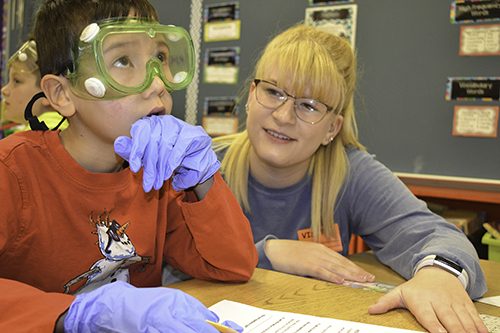
REACT board member Emilee Nawa engages with a second grader who's making predictions during a visit to Ms. Jones' classroom on April 5th.
When members of Illinois’ REACT (Reaching and Educating America's Chemists of Tomorrow) program visited Sangamon Elementary School’s 2nd grade classrooms the week of April 4–8 to lead the students in several chemistry activities, it was a win-win for all involved. The teachers met some of their Next Generation Science standards about the properties of matter. REACT students had the rewarding experience of giving back to their community. And while participating in several hands-on activities and demonstrations, the 2nd-graders learned some things about chemistry…and discovered that science is fun.
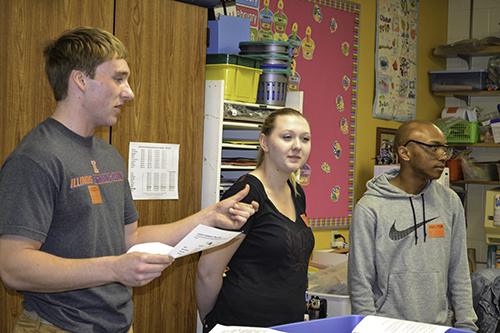
REACT volunteers explain a hands-on activity to Ms. Jones' second grade students.
Teachers in Illinois are now required to meet the new Next Generation Science Standards for science instruction. So when the second grade teachers in Mahomet’s Sangamon Elementary were wrestling with how to make this material come alive, Kelli Benner, a second grade teacher, decided to contact Illinois’ REACT program for some help.
“We wanted to come up with ways that students could get hands-on learning experiences that correlate with what we're teaching in class,” Benner explains. “So the REACT program from Chemistry said that they could create a presentation to put on for our students that would match up with our standards.”
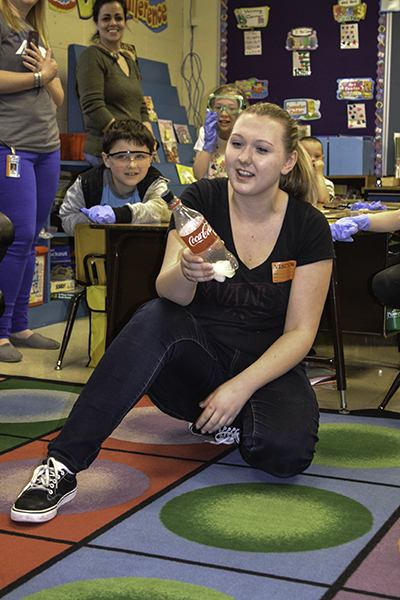
REACT volunteer Kelsey Finnamore demonstrates the bottle rocket to the students.
And according to Benner, it was exactly what they needed. “It worked perfectly!" she claims. “It talked about all the different properties of matter, and we're studying that right now. So along with the introduction that we're doing in our classrooms, it matched up perfectly and they were able to do experiments with what we've been learning about.”
The activities the REACT students did dealt with the states of matter (solids, liquids, and gases), density, and how chemical reactions can cause pressure to build up and be released. For instance, during one activity, students created a lava lamp. Oil was added to a small amount of colored water which, because it was denser, settled to the bottom. Then, to make the “lava” erupt, a half tablet of Alka-Seltzer was added; the chemical reaction caused ome of the red liquid bubble up to the top like a lava lamp.
In another activity, a bottle rocket, a small amount of baking soda was added to water in a bottle, which was corked. To the students’ delight, enough air pressure built up to pop the cork.
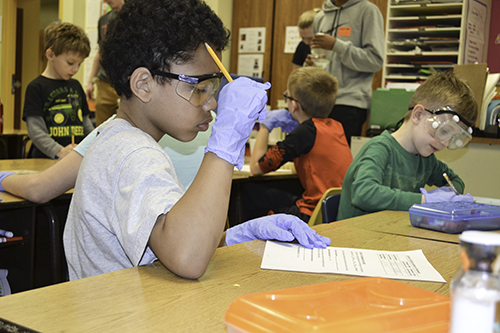
A student writes down what he predicts will happen during the activity.
To increase students' learning during the hands-on activities, they also did worksheets. Before each activity, they were to predict what they thought would happen, then record what actually happened and if they had been right or wrong.
Benner is a big fan of hands-on activities like the ones the REACT team introduced to her students.
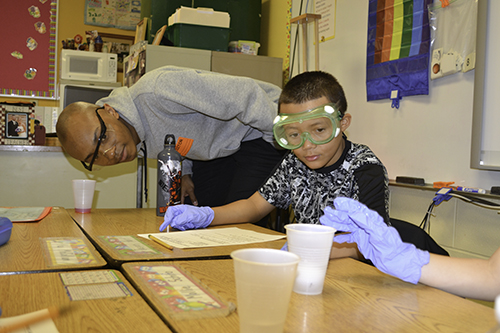
REACT volunteer Vincent Cornelius (left) and a second grader look to see if a the golf ball is floating in the salt water.
“I feel like it makes a better impact on their learning. It helps them to remember it. A lot of kids are visual learners and learn better by experiencing it and doing it, rather than just seeing it and learning it in a book or on paper or even in a video. I feel like just by them experiencing it, it's going to leave a lasting impact on their education.”
According to Benner, the REACT team’s activities had a very positive impact on her students.
“My students just loved it,” Benner says, regarding the five different experiments the REACT team did with her students. “They just thought every single one of them was engaging and exciting, and they couldn't wait to see what happened next.”
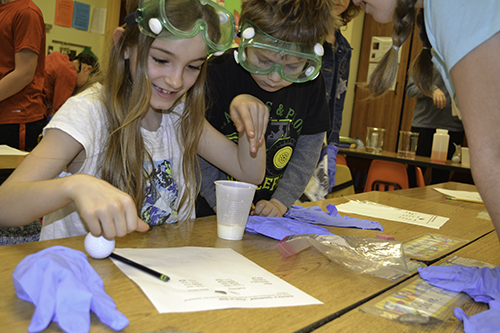
A Sangamon 2nd grader (left) enjoys discovering which of her predictions were correct.
Helping during the presentation to Ms. Jones’ second grade class was REACT board member Emilee Nawa. A senior majoring in Molecular and Cellular Biology, with a minor in Chemistry, she's also the REACT 3rd Grade Coordinator. Nawa enjoys participating in REACT because of the impact it has on the children they interact with.
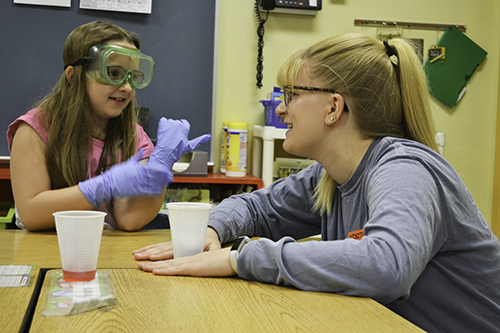
REACT board member Emilee Nawa interacts with a second grader during the outreach.
“Every visit I have been on, the students show so much gratitude and excitement towards the experiments we bring with us,” she says. “It is a great feeling to be able to help them learn about chemistry in a hands-on way.”
Nawa believes outreach efforts like the classroom visits at Sangamon are beneficial “to show these kids that we can relate science to everyday life.” Another benefit? The possibility of recruiting youngsters into science:
“We engage students in a fun way, especially those interested in pursuing science when they get older,” she admits.
Email REACT

REACT volunteer Vincent Cornelius waits for the raisins in the right beaker to float.
Story and photographs by Elizabeth Innes, Communications Specialist, I-STEM Education Initiative.
More: K-6 Outreach, Chemistry, REACT, 2017
For more articles about Chemistry and REACT, see:
- REACT: Recruiting Tomorrow's Chemists Today Via Fun, Hands-On Activities
- Chemistry's Holiday Magic Show Does a Bang-Up Job Saying, “Merry Christmas!”
- Barkstall STEM Night Exposes Students and Their Families to Fun Science and Engineering
- REACT: Reaching and Educating Tomorrow's Chemists Today
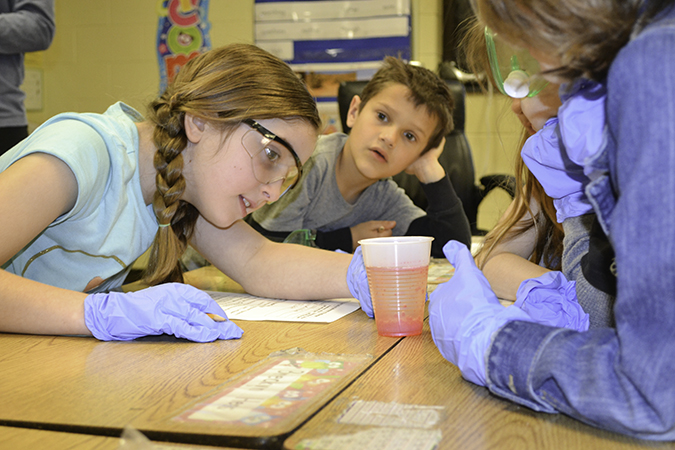
Sangamon second graders watch as their "lava lamp" bubbles.













.jpg)
















